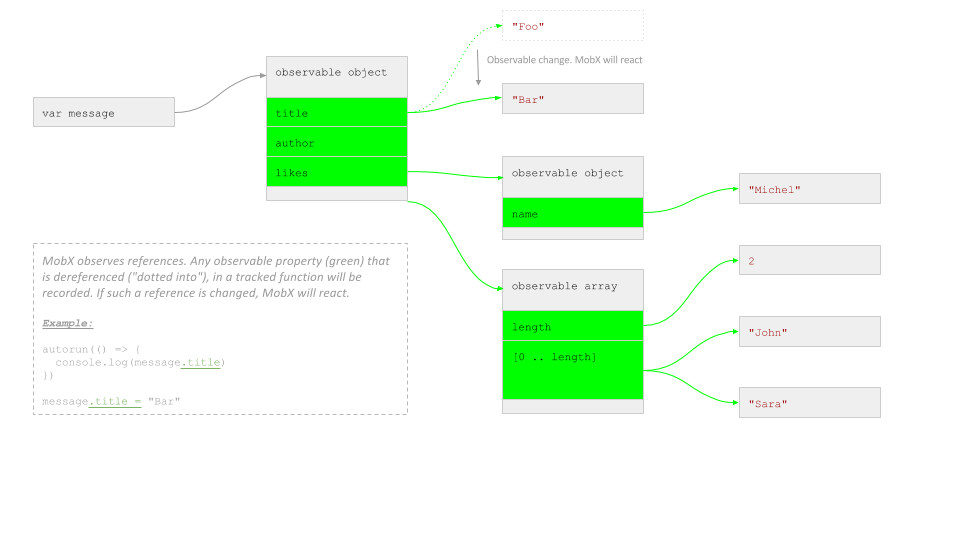- Introduction
- 1. MobX 简介
- 2. API 概述
- 3. 可观察类型
- 4. 理解如何响应
- 5. 如何使用装饰器
- 6. 相关资源
- 7. 提示 & 技巧
- 8. 工具方法
- 9. 捐赠
- Published with GitBook
什么情况下MobX才会响应(react)?
MobX通常会像你所想的那样响应,可以说90%的情况下你所使用的MobX都可以顺利工作。 然而,在某些时候你可能会遇到不符合你期望的情况,在这一点上,理解MobX是如何确定它需要如何响应是非常宝贵的。
在可追踪函数执行过程中,如果任一 已被观察 的 属性(property) 被 使用(read) 时,这个被观察的属性会触发响应
原文:MobX reacts to any existing observable property that is read during the execution of a tracked function.
- "使用" 是对对象属性的解引用。可以通过点引用的方式(如
user.name)或者中括号的使用方式(如user['name']) - "可追踪的函数" 是对一些函数的表述:如
computed;如一个观察者组件的render方法;或者是传给when,reaction和autorun三个函数的第一个参数 - "在XX的执行过程中" 意味着被观察对象只有在函数的执行过程中被使用。至于直接使用或是间接使用,都不是问题。
换句话说,以下情况MobX不会响应:
- 值虽然是通过被观察者获取的,这一过程却不在追踪函数中。
- 被观察者在一个异步的代码段中被使用
MobX追踪的是属性,而不是属性对应的值
为了更加清晰地用例子阐明上述规则,假设你有如下一个可观察的数据结构(可观察作用于一个对象时默认是递归的,所以这个例子中的所有字段都是可观察的)
let message = observable({
title: "Foo",
author: {
name: "Michel"
},
likes: [
"John", "Sara"
]
})
在内存中这个过程看起来如下图,绿方块代表可观察的属性。注意值本身不是可观察的

例子
让我们来看看一些例子(基于上述定义的 message 变量)
正确: 在被追踪函数中解引用
autorun(() => {
console.log(message.title)
})
message.title = "Bar"
这会像预期的那样进行响应,.title 在autorun中被解引用。然后在后续被改变,所以这个改变是可以被检测到的。
This will react as expected, the .title property was dereferenced by the autorun, and changed afterwards, so this change is detected.
你可以通过在跟踪函数内调用的 whyRun() 来验证MobX将跟踪哪些内容。在这个例子中,它将输出以下内容:
autorun(() => {
console.log(message.title)
whyRun()
})
// Outputs:
WhyRun? reaction 'Autorun@1':
* Status: [running]
* This reaction will re-run if any of the following observables changes:
ObservableObject@1.title
不正确: 改变一个不可观察的引用
autorun(() => {
console.log(message.title)
})
message = observable({ title: "Bar" })
这不会响应,message 改变了,但 message 并不是可观察的,只是一个引用,指向一个可观察的对象,但这个引用本身不是可观察的。
(译者按:这是说,改变message中如title之类的属性,是会响应的,但重新给message赋一个新对象,则不会进行响应)
不正确:在追踪函数外被解引用
var title = message.title;
autorun(() => {
console.log(title)
})
message.title = "Bar"
这不会响应,message.title 在 autorun 之外被解引用了,而被传进来的只是 message.title 的值,title 本身不是可观察的,所以 autorun 不会响应
正确: 在被追踪函数内解引用
autorun(() => {
console.log(message.author.name)
})
message.author.name = "Sara";
message.author = { name: "John" };
两次改变都会正常响应。author 和 author.name 都用的是点调用的方式,允许MobX去追踪它们的引用。
不正确: 将可观察的对象通过新声明变量进行引用,将不会有追踪
const author = message.author;
autorun(() => {
console.log(author.name)
})
message.author.name = "Sara";
message.author = { name: "John" };
第一个改变会发生,message.author 和 author 指向同一个对象,并且 .name 是在autorun中解引用
但第二个改变不会发生,message.author 这个关系在 autorun 没被追踪,Autorun始终使用的是『旧』的 author
正确: 在追踪函数中调用数组的属性
autorun(() => {
console.log(message.likes.length);
})
message.likes.push("Jennifer");
这会如预期一样响应。.length 计数是一个属性,注意会对array中的每一个变化进行响应。Array不是通过其中的每一个元素或属性进行追踪,而是整体追踪。
不正确: 在追踪函数中调用越界索引
autorun(() => {
console.log(message.likes[0]);
})
message.likes.push("Jennifer");
如果用的是之前的数据,上述这个例子会响应,数组索引(index)被作为属性一样调用,但是只在 index < length 的情况下才会生效。
MobX 不会追踪一个还不存在的属性(除非使用maps),所以确保你使用的数组引用小于该数组的长度。
正确: 在追踪函数中调用数组相关函数
autorun(() => {
console.log(message.likes.join(", "));
})
message.likes.push("Jennifer");
这会如预期一样响应。所有不会改变数组的数组相关函数都会被自动追踪
autorun(() => {
console.log(message.likes.join(", "));
})
message.likes[2] = "Jennifer";
这会如预期一样响应。所有的数组索引都会被检测,但只在 index < length的情况下
不正确: "使用" 一个可观察对象,但并不调用任何它的属性
autorun(() => {
message.likes;
})
message.likes.push("Jennifer");
这不会响应。因为 likes 这个数组本身并没有被 autorun 使用,只是放了个引用在这里。
对照来看,写成 messages.likes = ["Jennifer"] 这样就会响应,因为改变的不是数组的内容,而是 likes 属性本身
不正确: 使用未被观察的对象属性
autorun(() => {
console.log(message.postDate)
})
message.postDate = new Date()
这不会响应。MobX只追踪可观察属性
不正确: 使用可观察对象中不存在的属性
Incorrect: using not yet existing observable object properties
autorun(() => {
console.log(message.postDate)
})
extendObservable(message, {
postDate: new Date()
})
这也不会响应。因为当追踪开始时,被追踪的属性还不存在。
但如果是其他可观察对象触发这个 autorun 重新执行(re-run),则 autorun 会重新开始很好地追踪 postDate 属性。
正确: 使用不存在的Map字段(entry)
const twitterUrls = observable(asMap({
"John": "twitter.com/johnny"
}))
autorun(() => {
console.log(twitterUrls.get("Sara"))
})
twitterUrls.set("Sara", "twitter.com/horsejs")
这 会 响应,因为可观察Map支持观察不存在的字段。
注意一开始会打印出 undefined。
你可以使用 twitterUrls.has("Sara") 先确认字段的存在。所以如果需要使用一个动态的字段集合,建议使用可观察Map。
MobX 只追踪同步调用的数据
function upperCaseAuthorName(author) {
const baseName = author.name;
return baseName.toUpperCase();
}
autorun(() => {
console.log(upperCaseAuthorName(message.author))
})
message.author.name = "Chesterton"
这会如预期一样响应。即使 author.name 并没有在 autorun 中解引用。
MobX始终会追踪 upperCaseAuthorName 中发生的一切解引用,因为这一切都是在autorun的 执行过程中 发生。
autorun(() => {
setTimeout(
() => console.log(message.likes.join(", ")),
10
)
})
message.likes.push("Jennifer");
这不会响应。因为在 autorun 的执行过程中没有可观察者被使用,而是在 setTimeout 中使用。
值得警告的是,传递一个渲染回调函数给React组件的情况下,如下面这个例子:
const MyComponent = observer(({ message }) =>
<SomeContainer
title = {() => <div>{message.title}</div>}
/>
)
message.title = "Bar"
初步看起来好像没什么问题,除了 <div> 没有通过 MyComponent 实际渲染出来( MyComponent 的渲染过程是已经被追踪的),而是通过 SomeContainer 来渲染 。所以确保 SomeContainer 的title正确地响应了一个 message.title 的新值, SomeContainer 也被当做了一个 observer 。如果 SomeContainer 来源于一个外部库,你可以通过在自己的无状态 observer 组件内包裹一层 div ,并且在回调中实例化来修正这个问题。如以下示例:
const MyComponent = observer(({ message }) =>
<SomeContainer
title = {() => <TitleRenderer message={message} />}
/>
)
const TitleRenderer = observer(({ message }) =>
<div>{message.title}</div>}
)
message.title = "Bar"
避免将可观察者缓存在本地变量中
一个常见的错误是将引用的可观察者缓存在本地变量中。例如:
@observer class MyComponent extends React.component {
author;
constructor(props) {
super(props)
this.author = props.message.author;
}
render() {
return <div>{author.name}</div>
}
}
当改变 author 的 name 时,这个组件的确会正确地响应,但改变 author 自身的时候,则不会正确地响应。因为解引用发生在 render() 这个 observer 组件唯一的追踪方法之外。
注意即使你将组件自身的 author 设置为 @observable ,也不能解决这个问题,因为这个属性只被初始化了一次。
可以通过简单地解决这个问题:将解引用放在 render() 内;或者引入一个计算值
@observer class MyComponent extends React.component {
@computed get author() {
return this.props.message.author
}
当多组件的情况下会如何渲染
假设我们使用如下组件,以渲染我们的 message对象
const Message = observer(({ message }) =>
<div>
{message.title}
<Author author={ message.author } />
<Likes likes={ message.likes } />
</div>
)
const Author = observer(({ author }) =>
<span>{author.name}</span>
)
const Likes = observer(({ likes }) =>
<ul>
{likes.map(like =>
<li>{like}</li>
)}
</ul>
)
| 变化 | 重渲染的组件 |
|---|---|
message.title = "Bar" |
Message |
message.author.name = "Susan" |
Author (.author is dereferenced in Message, but didn't change)* |
message.author = { name: "Susan"} |
Message, Author |
message.likes[0] = "Michel" |
Likes |
注意:
- * 如果
Author组件被唤起时使用的是<Author author={ message.author.name} />这样的方式。则Message会成为解引用组件,并响应message.author.name的变化。 尽管如此,<Author>仍然会正常地渲染,因为它接受了一个新值。但为了性能的考虑,我们应该尽可能晚地解引用。 2、 ** 如果 likes不是一个字符串而是一个对象,并且他们被自己的Like组件所渲染,则其中具体的某个like发生改变时,Likes不会触发重渲染。
总而言之(TL;DR)
在可追踪函数执行过程中,如果任一 *已被观察 的属性(property) 被 使用(read) 时,这个被观察的属性会触发响应 MobX reacts to any an _existing *observable property that is read during the execution of a tracked function.